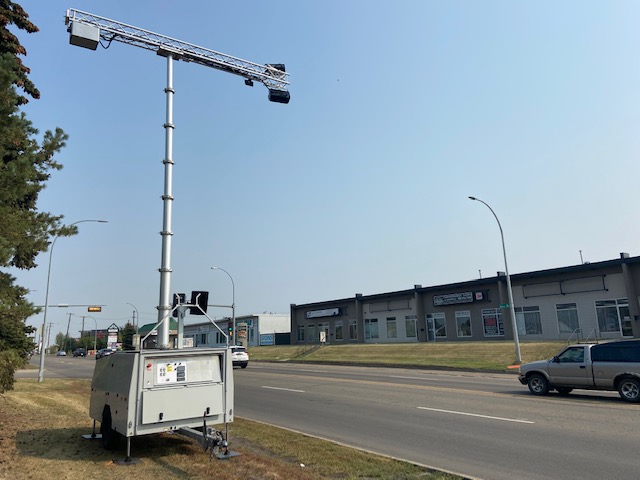Artificial intelligence could soon help catch distracted drivers in Edmonton.
The University of Alberta is testing a new system that’s similar to photo radar, but catches drivers on their phone.
The large device looks like a power generator or light tower used on a construction site. It was switched on Tuesday and will track data along Argyll Road in south Edmonton and in two other locations for the next three weeks.

U of A pilot project that tracks distracted drivers through its technology seen along Argyll Road in Edmonton, Alta. on September 13, 2022.
Global News
‘It uses sensors to capture high-resolution images through windshields,” said Karim El-Basyouny, the urban traffic safety research chair at the University of Alberta.
“The artificial intelligence is trained to detect phone use from large datasets, allowing the system to pick up on multiple cues that may indicate distracted driving.”
He said the pilot project is for testing only and won’t result in traffic enforcement for now.
“What we’re trying to do here is see if there is a better understanding on how big of an issue it is,” El-Basyouny said.
“The work is going to help us better understand what policies need to be in place in the future.
“Enforcement can potentially be one of the tools that we can use.”
The University of Alberta teamed up with Edmonton Police Service to bring the automated technology, created by Acusensus, to Canada through a grant.
Tony Parrino, the general manager of Acusensus in North America, said it’s a radar-based system that will not put your privacy or personal information at risk and the images are reviewed in the final step by trained humans, to avoid any false positives.
“We’re looking at four different distinct angles down into the windscreen windshield of the vehicle behind the dash. We’ve got a shallow camera that looks at the phone-to-ear event and then we have a colour context camera and then a plate camera to identify those vehicles,” Parrino said.
Even driver Jack Shultz is on board — and he actually hates photo radar so much he created a Facebook group called Edmonton Cash Cows.
“I’m against photo or automated traffic enforcement but I am in agreeance with trying to curb the situation and get a roads back to being safe,” Shultz said.
“It makes me think about 2017, when me and my family were T-boned by a gentleman using a cell phone — we were T-boned and hospitalized. My common-law wife had to have reconstructive surgery.”
That’s a fate this project hopes others will avoid, thanks to technology.
The U of A also states the findings from this project will also inform future decisions on the use of such technology in improving safety and contributing to the city’s goal of ‘Vision Zero’ – which is to have zero traffic-related serious injuries and fatalities
